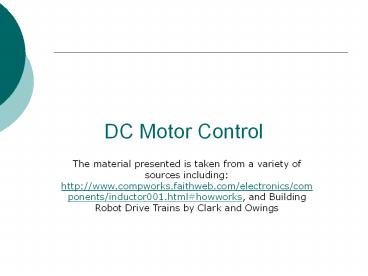DC Motor Control PowerPoint PPT Presentation
Title: DC Motor Control
1
DC Motor Control
- The material presented is taken from a variety of
sources including http//www.compworks.faithweb.c
om/electronics/components/inductor001.htmlhowwork
s, and Building Robot Drive Trains by Clark and
Owings
2
Voltage
- A motor requires a power source within its
operating voltage, i.e., the recommended voltage
range for best efficiency of the motor. - Lower voltages will usually turn the motor (but
provide less power). - Higher voltages, in some cases, can increase the
power output but almost always at the expense of
the operating life of the motor.
3
Current
- When constant voltage is applied, a DC motor
draws current in the amount proportional to the
work it is doing. - For example, if a robot is pushing against an
obstacle, it is drawing more current than when it
is moving freely in open space. - The reason is the resistance to the motor motion
introduced by the obstacle. - If the resistance is very high the motor draws a
maximum amount of power, and stalls. This is
defined as the stall current of the motor the
most current it can draw at its specified
voltage.
4
Control
- A microprocessor cannot drive the motor directly
(Not enough current supply) - The motor power must come from another source
only control signals come from the microprocessor - Control Topics
- Basic H-Bridges
- Isolation
- Pulse-width modulation
5
H-bridge
- The basic circuit for driving DC motors in both
directions is an H-bridge. This circuit enables
the motor to spin in either direction from a
single power supply.
6
Noise
- A DC motor can create a tremendous amount of
power supply noise. Why? - Current demand When a motor starts or changes
direction, it draws a great deal of current
almost behaving as a short circuit. - Commutator brush noise As the brushes make and
break contact with the communtator, power to the
coils is switched on and off. As a result of
inductance, the coils generate a brief high
voltage spike as the current is switched off.
7
Inductance
- An inductor resists change in current flow.
- You learned that when current flows through a
conductor, a magnetic field surrounds the
conductive wire. The more current traveling
through the wire the greater the amount of flux.
What you didn't learn is that these lines of flux
can generate voltage on surrounding conductors. - Induced voltage results from change in current
flow. At steady state, the induced EMF
collapses. - The voltage that appears in the inductor (i.e.,
the motor) is of opposite polarity to the
original voltage and is called Counter Electro
Motive Force (CEMF). - The faster the current changes, the larger the
CEMF voltage. Spike of 20 times the original
voltage can appear.
8
A Better H-bridge
9
Pulse Width Modulation
- Pulse width modulation is a technique for
reducing the amount of power delivered to a DC
motor. - Instead of reducing the voltage operating the
motor (which would reduce its power), the motor's
power supply is rapidly switched on and off. - The percentage of time that the power is on
determines the percentage of full operating power
that is accomplished.
10
PWM
75
50
25
11
Which PWM frequency is best
- A wide range of frequencies could be used for the
pulse width modulation signal. - Frequencies above 1K Hz are recommended.
- Lower frequencies may resonate and cause your
motor to vibrate.
12
Lynxmotion DC Motor Controller
13
Control Truth Table
14
BS2 Code
- ' ----- I/O Definitions ------------------------
----------- - Aenable PIN 0
- Aminus PIN 2
- Aplus PIN 3
- Benable PIN 1
- Bminus PIN 4
- Bplus PIN 5
- ' ----- Variables ------------------------------
----------- - loopCnt VAR Byte
- '------ turn both motors CCW B fast and A slow
----------- - ' set motor B to turn fast CCW
- HIGH Benable ' set B enable
- HIGH Bminus ' set B-
- LOW Bplus ' set B
- ' set motor A to turn slow CCW
- HIGH Aminus ' set A-
- LOW Aplus ' set A
- ' loop used to pluse Aenable
- FOR loopcnt 0 TO 1000

